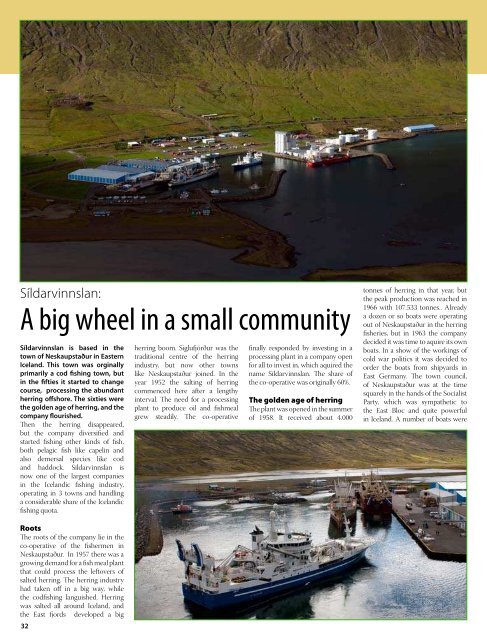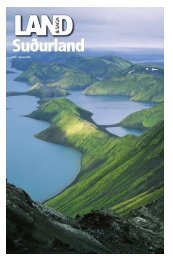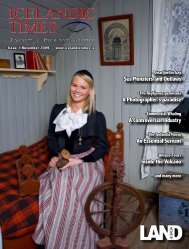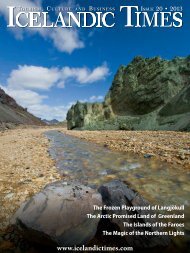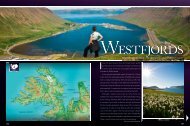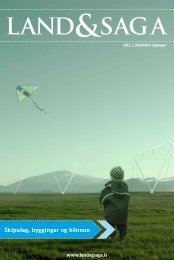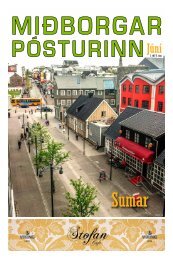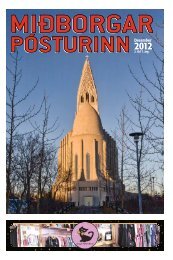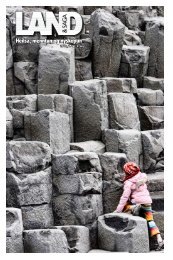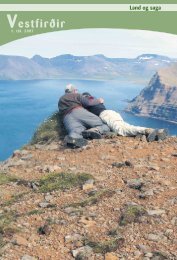You also want an ePaper? Increase the reach of your titles
YUMPU automatically turns print PDFs into web optimized ePapers that Google loves.
Síldarvinnslan:A big wheel in a small communitySíldarvinnslan is based in thetown of Neskaupstaður in EasternIceland. This town was orginallyprimarily a cod fishing town, butin the fifties it started to changecourse, processing the abundantherring offshore. The sixties werethe golden age of herring, and thecompany flourished.Then the herring disappeared,but the company diversified andstarted fishing other kinds of fish,both pelagic fish like capelin andalso demersal species like codand haddock. Síldarvinnslan isnow one of the largest companiesin the Icelandic fishing industry,operating in 3 towns and handlinga considerable share of the Icelandicfishing quota.RootsThe roots of the company lie in theco-operative of the fishermen inNeskaupstaður. In 1957 there was agrowing demand for a fish meal plantthat could process the leftovers ofsalted herring. The herring industryhad taken off in a big way, whilethe codfishing languished. Herringwas salted all around Iceland, andthe East fjords developed a bigherring boom. Siglufjörður was thetraditional centre of the herringindustry, but now other townslike Neskaupstaður joined. In theyear 1952 the salting of herringcommenced here after a lengthyinterval. The need for a processingplant to produce oil and fishmealgrew steadily. The co-operativefinally responded by investing in aprocessing plant in a company openfor all to invest in, which aquired thename Síldarvinnslan. The share ofthe co-operative was originally 60%.The golden age of herringThe plant was opened in the summerof 1958. It received about 4.000tonnes of herring in that year, butthe peak production was reached in1966 with 107.533 tonnes.. Alreadya dozen or so boats were operatingout of Neskaupstaður in the herringfisheries, but in 1963 the companydecided it was time to aquire its ownboats. In a show of the workings ofcold war politics it was decided toorder the boats from shipyards inEast Germany. The town council,of Neskaupstaður was at the timesquarely in the hands of the SocialistParty, which was sympathetic tothe East Bloc and quite powerfulin Iceland. A number of boats wereIn the ninetiesshrimp trawling wasamong the newdirections takenby Síldarvinnslan.There were steadyimprovement intechnol<strong>og</strong>y in thecapelin fisheries,with technol<strong>og</strong>icallyadvanced ships likeBeitir and Börkurbuilt in East Germany for Icelanders,not only for Síldarvinnslan. The twonew ships came to Neskaupstaðurin 1965. Two more boats, built inNorway, came in 1966 and 1967.New challengesIn 1967-1968 the herring bonanzacame to an end, the herringdisappeared and new ways hadto be found to occupy the fleet.Capelin came to the rescue, thehitherto little in-demand pelagicfish had been swimming fearlesslyin Icelandic waters but becauseof the disappearance of herringnow became the object of intensehunting efforts. The technol<strong>og</strong>icallyvery advanced herring fleet couldbe employed to catch this fish inimmense numbers and soon theprocessing plants were hummingagain. In 1973 a new ship, BörkurNK 122, was bought and this was thelargest ship used for fishing pelagicfish ever seen in Iceland. It had thecapacity of catching over 1000 tonson each fishing tour.Moreover, the interest for cod hadgrown. A new kind of trawler hadbeen seen in Icelandic waters, thekind were the trawl was let outand taken in at the rear end, calledstern trawlers, but no Icelandershad invested in such ships. In 1965times were lean for cod fishing, andSíldarvinnslan took over some of theoperations of the co-operative SUN.This involved Síldarvinnslan buyingthe freezing plant of the co-operativeand a host of plants and equipment.Síldarvinnslan had now becomeinvolved in the demersal speciesindustry. It started to produce saltfish as well as frozen fish. In 1970the company was the first companyin Iceland to aquire a stern trawler.Most fishing companies in Icelandfollowed suit in the next decade.Disaster strikesOn the 20th December 1974 disasterstruck. The town of Neskaupstaðurwas hit by two enormous avalanches,which killed twelve people, destroyedthe fish meal plant and damagedthe freezing plant and much more.Seven of those killed were employedby Síldarvinnslan. This was a heavyblow to the town and almost all ofthe production facilities in the townwere destroyed. It was four daysbefore Christmas, in the darkestperiod of the year. These were darkdays indeed in Neskaupstaður.Rebuilding started immediately.Until March 1975 all the fish caughtwas salted, but then the freezingplant resumed operations with anew fish meal plant opening almosta year later. In february 1976 thefirst capelin was processed and therebuilding came to an end.After the cod warsIn the seventies the course was set forthe company, with capelin and codthe mainstays of the fishing industry.The cod wars changed the situationfor the Icelandic fishing industry,obtaining exclusive rights to thefishing grounds around Iceland forIcelanders. Others were excluded,but not without resistance. The codwars between Iceland and Britainraged intermittantly from 1971 until1976, when the British finally threwin the towel.In the nineties shrimp trawling wasamong the new directions taken bySíldarvinnslan. There were steadyimprovement in technol<strong>og</strong>y in thecapelin fisheries, with technol<strong>og</strong>icallyadvanced ships like Beitir andBörkur. In the demersal fisheries thetendency was to equip the trawlerswith freezing plants so the fish couldbe frozen directly at sea, as fresh aspossible.A giant in the east, and inevery part of the countrySíldarvinnslan is now one of thelargest fishing companies in Iceland.It is the biggest company in pelagicfisheries and it is leading in theproduction of fish meal and fishoil. It operates in three towns inIceland. It handles fishing quotaswhich are the equvalent of 20.000cod fish tonnes. About 210 peoplework for the company and theturnover was 90 million US dollarsin 2009. Síldarvinnslan operatesa technol<strong>og</strong>ically advanced plantin Neskaupstaður, freezing bothdemersal and pelagic fish. It operatesno less than three well equipedprocessing plants for producing fishmeal and fish oil, in Neskaupstaður,Seyðisfjörður and Helguvík nearKeflavík. It owns two large ships whofish pelagic species, one freezingtrawler and one ice trawler. To findout more please see their website :www.svn.is.32 33


